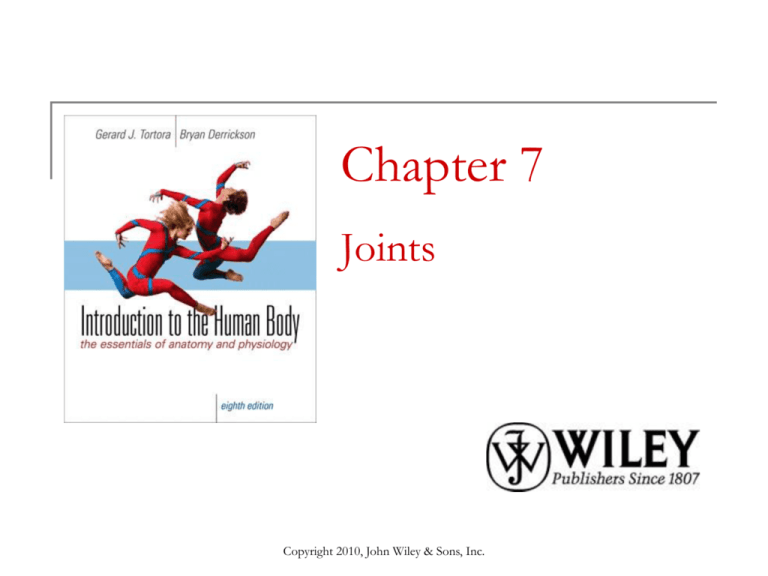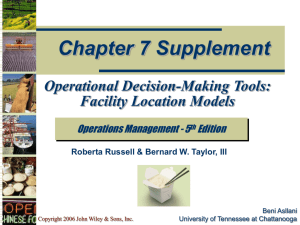
Chapter 7
Joints
Copyright 2010, John Wiley & Sons, Inc.
End of Chapter 7
Copyright 2010 John Wiley & Sons, Inc.
All rights reserved. Reproduction or translation of this
work beyond that permitted in section 117 of the 1976
United States Copyright Act without express permission
of the copyright owner is unlawful. Request for further
information should be addressed to the Permission
Department, John Wiley & Sons, Inc. The purchaser may
make back-up copies for his/her own use only and not
for distribution or resale. The Publishers assumes no
responsibility for errors, omissions, or damages caused
by the use of theses programs or from the use of the
information herein.
Copyright 2010, John Wiley & Sons, Inc.
Joints
Points where bones meet
Classifications
Structurally: by their anatomy
Fibrous, cartilaginous, or synovial
Functionally: by the degree of movement they
permit
Immovable, slightly movable, and freely movable
Copyright 2010, John Wiley & Sons, Inc.
Structural Classification
Based on what is between bones:
Space (or not)
Type of connective tissue present
Types
Fibrous joints - no cavity, just dense irregular
connective tissue
Cartilaginous joints - no cavity, bones held
together by cartilage
Synovial joints - have synovial cavity, dense
irregular tissue of articular capsule, and often
ligaments
Copyright 2010, John Wiley & Sons, Inc.
Functional Classification
Based on degree of movement they permit
Types
Synarthrosis: immovable
Amphiarthrosis: slightly movable
Pelvis, sutures, teeth
Epiphyseal plate, tibia-fibula, vertebrae, pelvic symphysis
Diarthrosis: freely movable
Most joints of the body
All diarthrotic joints are synovial
Copyright 2010, John Wiley & Sons, Inc.
Fibrous Joints
Suture (synarthrosis)
Joined by thin layer of dense fibrous connective
tissue
Example: between bones of skull
Syndesmosis
Greater distance between bones and greater
amount of dense irregular connective tissue
Examples
Distal tibia to distal fibula (amphiarthrosis)
Gomphosis (synarthrosis): tooth root in socket
(alveolar process) of mandible or maxilla
Copyright 2010, John Wiley & Sons, Inc.
Fibrous Joints
Interosseous membrane (amphiarthrosis)
Has greater amount of dense irregular
connective tissue
Examples: extensive membranes between shafts
of some long bones
Radius-ulna
Tibia-fibula
Copyright 2010, John Wiley & Sons, Inc.
Fibrous Joints
Copyright 2010, John Wiley & Sons, Inc.
Fibrous Joints
Copyright 2010, John Wiley & Sons, Inc.
Fibrous Joints
Copyright 2010, John Wiley & Sons, Inc.
Cartilaginous Joints
Synchondrosis (synarthrosis)
Cartilage connects two areas of bone
Example
Epiphyseal (growth) plate connecting epiphysis and
diaphysis of long bone (synarthrosis)
Symphysis (amphiarthrosos)
Cartilage connects two bones, but a broad disc of
fibrocartilage is present also
Examples: pubic symphysis and intervertebral
discs
Copyright 2010, John Wiley & Sons, Inc.
Cartilaginous Joints
Copyright 2010, John Wiley & Sons, Inc.
Cartilaginous Joints
Copyright 2010, John Wiley & Sons, Inc.
Synovial Joints: Structure
Synovial cavity: space containing fluid
Articular cartilage
Covers ends of bones, absorbs shock
Articular capsule
Inner layer: synovial membrane that secretes
synovial fluid (reduces friction, supplies nutrients)
Outer layer: dense, irregular connective tissue
Copyright 2010, John Wiley & Sons, Inc.
Synovial Joints: Structure
In some cases synovial joints include:
Ligaments (either inside or outside of joint cavity)
Menisci (cartilage discs)
Articular fat pads
Bursae
Sacs made of synovial membranes containing fluid
Located where friction can occur
Examples: between skin-bone, tendons-bones,
muscles-bones, ligaments-bones
Copyright 2010, John Wiley & Sons, Inc.
Synovial Joints: Structure
Copyright 2010, John Wiley & Sons, Inc.
Knee Joint
Copyright 2010, John Wiley & Sons, Inc.
Knee Joint
Copyright 2010, John Wiley & Sons, Inc.
Knee Joint
Copyright 2010, John Wiley & Sons, Inc.
Knee Joint
Copyright 2010, John Wiley & Sons, Inc.
Types of Movements at Synovial Joints
Gliding
Flexion
Decrease in angle between articulating bones
Extension
Flat bone surfaces moving across each other
Increase in angle between articulating bones
In anatomical position the body is in full extension
Hyperextension
Bending beyond 180o degrees, such as moving
humerus backwards behind anatomical position
Copyright 2010, John Wiley & Sons, Inc.
Types of Movements at Synovial Joints
Copyright 2010, John Wiley & Sons, Inc.
Types of Movements at Synovial Joints
Copyright 2010, John Wiley & Sons, Inc.
Types of Movements at Synovial Joints
Copyright 2010, John Wiley & Sons, Inc.
Types of Movements at Synovial Joints
Copyright 2010, John Wiley & Sons, Inc.
Types of Movements at Synovial Joints
Copyright 2010, John Wiley & Sons, Inc.
Types of Movements at Synovial Joints
Copyright 2010, John Wiley & Sons, Inc.
Movements
Abduction
Adduction
Movement of bone toward midline
Circumduction
Movement of bone away from midline
Movement of distal end in a circle
Rotation
Bone revolves around its own longitudinal axis
Copyright 2010, John Wiley & Sons, Inc.
Types of Movements at Synovial Joints
Copyright 2010, John Wiley & Sons, Inc.
Types of Movements at Synovial Joints
Copyright 2010, John Wiley & Sons, Inc.
Types of Movements at Synovial Joints
Copyright 2010, John Wiley & Sons, Inc.
Types of Movements at Synovial Joints
Copyright 2010, John Wiley & Sons, Inc.
Types of Movements at Synovial Joints
Copyright 2010, John Wiley & Sons, Inc.
Types of Movements at Synovial Joints
Copyright 2010, John Wiley & Sons, Inc.
Types of Movements at Synovial Joints
Copyright 2010, John Wiley & Sons, Inc.
Special Movements
Elevation
Depression
Movement downward
Protraction
Movement upward
Movement forward
Retraction
Movement backward into anatomical position
Copyright 2010, John Wiley & Sons, Inc.
Special Movements at Synovial Joints
Copyright 2010, John Wiley & Sons, Inc.
Special Movements at Synovial Joints
Copyright 2010, John Wiley & Sons, Inc.
Special Movements
Inversion
Eversion
Move soles laterally
Dorsiflexion
Move soles medially
Bend foot toward dorsum (“stand on heels”)
Plantar flexion
Bend foot toward plantar surface (“stand on toes”)
Copyright 2010, John Wiley & Sons, Inc.
Special Movements at Synovial Joints
Copyright 2010, John Wiley & Sons, Inc.
Special Movements at Synovial Joints
Copyright 2010, John Wiley & Sons, Inc.
Special Movements at Synovial Joints
Supination
Movement of forearm so palms face forward or
upward
Pronation
Movement of forearm so palms face backward or
downward
Copyright 2010, John Wiley & Sons, Inc.
Special Movements at Synovial Joints
Copyright 2010, John Wiley & Sons, Inc.
Six Types of Synovial Joints
Planar joints
Articulating surfaces flat or slightly curved
Examples: between carpals, tarsals, sternumclavicle, scapula-clavicle
Movements: gliding
Hinge joints
Convex-to-concave surfaces
Examples: elbow, knee, ankle, interphalangeal
Movements: flexion (F) and extension (E) only
Copyright 2010, John Wiley & Sons, Inc.
Types of Synovial Joints
Pivot joints
Rounded surface with ring formed by bone and
ligament
Examples: atlantoaxial joint (to turn head to say
“no”) and radius-ulna for pronation-supination
Movement: rotation (ROT)
Condyloid joints
Convex oval surface to concave oval surface
Examples: wrist, metacarpophalangeal-2 to -5
joints
Movements F, E, ABD, ADD
Copyright 2010, John Wiley & Sons, Inc.
Types of Synovial Joints
Saddle joints
One side of saddle-shaped, other like a rider
astride it
Example: trapezium (carpal) to metacarpal-1
(thumb)
Movements: triaxial (F, E, ABD, ADD, ROT)
Ball-and-socket joints
Ball-like surface into cuplike socket surface
Example: shoulder, hip
Movements: triaxial (F, E, ABD, ADD, CIR, ROT)
Copyright 2010, John Wiley & Sons, Inc.
Types of Synovial Joints
Copyright 2010, John Wiley & Sons, Inc.
Types of Synovial Joints
Copyright 2010, John Wiley & Sons, Inc.
Types of Synovial Joints
Copyright 2010, John Wiley & Sons, Inc.
Types of Synovial Joints
Copyright 2010, John Wiley & Sons, Inc.
Types of Synovial Joints
Copyright 2010, John Wiley & Sons, Inc.
Types of Synovial Joints
Copyright 2010, John Wiley & Sons, Inc.
Details of a Synovial Joint: Knee Joint
See slides 10a-d
Ligaments
Menisci (medial and lateral)
Tibial and fibular collateral ligaments
Anterior cruciate ligament (ACL): 70 % of knee injuries
Posterior cruciate ligament (PCL)
Fibrocartilage discs that increase stability of knee joint
Bursae
Arthroplasty
Knee replacement: total or partial
Copyright 2010, John Wiley & Sons, Inc.
Aging of Joints
Decrease in production of synovial fluid
Thinning of articular cartilage
Ligaments shorten and lose flexibility
Influenced by genetic factors
Copyright 2010, John Wiley & Sons, Inc.
Common Disorders of Joints
Common joint injuries
Rotator cuff injury
Separated shoulder
Tennis elbow
Dislocation of the radial head
Knee injuries: swollen knee, rupture of tibial
collateral ligaments, dislocated knee
Rheumatism: rheumatoid arthritis, osteoarthritis
Ligaments shorten and lose flexibility
Influenced by genetic factors
Copyright 2010, John Wiley & Sons, Inc.
End of Chapter 7
Copyright 2010 John Wiley & Sons, Inc.
All rights reserved. Reproduction or translation of this
work beyond that permitted in section 117 of the 1976
United States Copyright Act without express permission
of the copyright owner is unlawful. Request for further
information should be addressed to the Permission
Department, John Wiley & Sons, Inc. The purchaser may
make back-up copies for his/her own use only and not
for distribution or resale. The Publishers assumes no
responsibility for errors, omissions, or damages caused
by the use of theses programs or from the use of the
information herein.
Copyright 2010, John Wiley & Sons, Inc.







